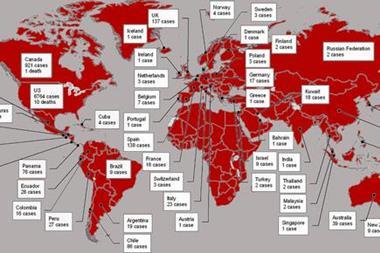The aerospace market will remain stable despite the Air France jet disaster
The Air France jet disaster in which 228 people died is another blow to the beleaguered airline insurance broker market and could have a big knock-on effect for the whole aerospace sector. Despite this, Aon argues, aerospace will stay relatively sheltered from any huge spike in premiums, writes Lauren MacGillivray.
The term “airline” refers to airline carriers, which after suffering high fuel costs have been hit by a drop in travel due to the economic crisis and swine flu. Meanwhile, the term “aerospace”, according to Aon’s report Aerospace Insurance Market Outlook 2009, includes manufacturers, service providers and airports.
“While the [Air France] incident will have an impact on sentiment in the airline insurance market, it is too early to say whether it will lead to higher premiums for the industry,” says Magnus Allan, aviation analyst and the report’s author. “Overall the past five years have seen a relatively low level of claims. Latent capacity in the insurance market continues to be quite high.”
Allan says recent improvements made by aerospace companies mean that flying is generally safer. “We’ve seen a lot of the air traffic control systems upgraded and so on,” he says.
“You can’t say for a fact that this has reduced the risk but the anecdotal evidence is that there’s been a lot of work over the past five years and the industry has become significantly safer. That has been helping the aerospace insurance market in terms of renewal prices over the past couple of years.”
But he admits that 2009 poses some big challenges. Last year there were two major crashes – British Airways flight BA38 crash landed at Heathrow in January with no fatalities, while Spanair flight JK5022 crashed in August just after take-off from Barajas Airport in Madrid, killing 154 people.
There has also been speculation that the Air France crash was the result of a malfunctioning speed sensor – a problem that also caused two incidents last autumn involving the same
A330 model operated by Qantas. A total of 70 passengers were injured in those incidents.
To add to this technical track record, there is of course the credit crunch to contend with.
Allan says: “With aerospace, it’s not been going through the traumatic peaks and troughs you’ve seen in airline over recent years. But there has been a definite sea change over the past six months to a year.
“The underwriters are having to respond to global capital providers’ needs to ensure they’re not running at a loss and that’s going to make the negotiation positions over the next few months very challenging.”
Nicholas Redgrove, a director in Cooper Gay's aerospace division, agrees. “In terms of rating, there will be increases for renewals on most of the aerospace income. In certain instances – industrial aid, jets, hull and war – you would be disappointed if you could not get a reduction.
“However, these sections of the business do not make a significant impact on overall aerospace income,” he says.
But Redgrove is concerned about a knock-on effect from airline. “The estimated losses so far in 2009 will in all likelihood exceed the airline annual premium income and we are still in the first half of the year. The market view is that the recent Air France loss will be significant, although an official reserve has not yet been established.”
He adds: “In all probability as a result of this loss there will be an immediate impact on the airline rates.”
Hardening market
Aerospace companies benefited from soft rates between the second quarter of 2007 and the third quarter of 2008. But in the final quarter of last year average lead premiums rose 6%, a hardening trend that is expected to continue this year.
In 2008, there were just five lead premium reductions in December and eight in November, which together equalled about a third of the total number of renewals during the final two months of 2008. In comparison, 69% of lead premium renewals were reduced for the whole year.
Allan believes the hardening in the final quarter was affected by the renewal of three big global operations that were hit with premium spikes because of historical claims.
It should also be noted that the final quarter only represented around 7% of the total lead premium for the year.
The hardening trend could be attributed to the influence of the airline insurance market. “Airline and aerospace underwriters tend to sit side by side in business terms, and can even be the same person,” Allan says, “which is one reason why the hardening stance being taken
in the airline market is so influential on the aerospace market, even where the competitive pressures are different.”
He says a big drop in the cost of airline in 2006 and 2007 meant underwriters probably made a loss, so they are looking to harden prices significantly. But he adds: “In aerospace it’s been a lot more constant. The declines have been a lot less severe, so the increases might not be as significant as in airline.”
Broker clients stay loyal
The hardening aerospace market has not caused a big jump in the number of operations looking to switch brokers or lead insurers, Aon says.
In 2008, 11% of aerospace operations changed lead insurer and 9% changed broker. This matched the average proportion of leader changes between 2003 and 2007, and was slightly higher than the 8% average of those who changed broker in that time.
By contrast, in the airline sector an average of 22% of airlines changed broker and 30% changed leader between 1999 and 2007. However, like the aerospace sector, airline didn’t experience a significantly higher proportion of changes in 2008 compared with the long-term averages.
“Given that the depths of the difficulties that the financial markets found themselves in only really began to become clear in the second half of [last] year, it will be interesting to see whether there is more activity in terms of broker or leader changes in 2009,” Allan says.
“At this stage, it seems there have been few rapid moves and organisations are waiting until the shape of the insurance markets is clearer.”
Fuller reserve tanks
Historically, aerospace organisations have not reserved enough – especially dangerous because loss investigations can take more than five years.
“There might be fingertip searches through the Amazon rainforest to find the right screw and find out when it got corroded,” Allan says. “These things take ages to work through and the legal ramifications of which jurisdiction they’re being claimed in can make it very complicated. So losses that happen today may not actually be settled until 2015.”
Aviation carries a high level of potential risk. Allan says: “If you’re a global airport operation and there’s a coup in a particular country, you stand to lose quite a lot in terms of your physical presence in that country.”
Other examples of risks include a problem with an aircraft part, debris left on a runway and the wrong fuel going into an aircraft.
With this in mind, it’s becoming standard for aerospace operations to have an accident reserve equal to the estimated limit as soon as an incident takes place.
Challenges and opportunities
With the economy in a slump, aerospace companies are being forced to change their business models. As airlines struggle to secure project finance, for example, some airframe manufacturers are starting to offer better deals and even loans to airline organisations.
But as orders for airframe manufacturers fall, maintenance, repair and overhaul operations are expected to be busier than usual because airlines will be looking to hold onto their aircraft longer.
Based on Aon’s data, the average age of an aircraft in the global fleet was 13.5 years in 2008 – its highest since 1997, and almost a year older than 2002, when the average was 12.7 years.
But the number of incidents that occur during an aircraft’s first 15 years has fallen when looking at the averages of 1995 to 2001 and 2002 to 2007. Aircraft between five and 10 years old have had the biggest drop in the number of incidents.
While crashes such as the Air France flight 447 incident are horrific, there are those who believe they need to be kept in perspective. According to Aon, aerospace losses have been relatively limited in the past couple of years as technologies continue to improve.
And while the market has been soft, it has not dropped as low as airline, which takes some pressure off insurers.
“While there is a temptation from insurers to be gloomy about the current financial position, the aerospace industry continues to demonstrate positive rewards for a modern, proactive risk management and quality control approach, improved loss control and mitigation of litigation,” says Steven Turner, a member of Aon Global’s UK aerospace division.
“This will result in the reduction of insurance claims and in turn risk transfer costs and added protection to a company’s balance sheet in both the good times and the difficult times.”
Hosted by comedian and actor Tom Allen, 34 Gold, 23 Silver and 22 Bronze awards were handed out across an amazing 34 categories recognising brilliance and innovation right across the breadth of UK general insurance.












































No comments yet